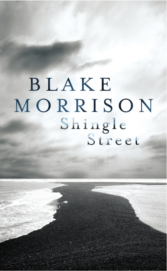 Blake Morrison
Blake Morrison
Chatto & Windus
by Jane Baston
From our first step on Shingle Street we feel the shifting terrain. This land where the sea meets the marshes is duplicitous; out there we must be vigilant for sandbanks, rip-tides, and wrecking grounds. Although the stones are “warm as stoves” we must beware the
sneaky street,
That smiles and mangles, lures and wrecks,
Where water strips and winds dissect,
Where sea-kale bows its green-grey head
As waves wash up the new-made dead
The regular structure of end-rhymed dimeters and tetrameters gives an incantatory power to this opening poem. In keeping with its form as a ballad, it has an intensity and immediacy that drives the reader on like the action of the waves:
The grind goes on,
A churning bowl
Of sand and stone.
A watery mix that unbuilds homes,
Unearthing earth, unlaying land.
This potency continues throughout Blake Morrison’s collection. Water washes through the poems, finding ingress to the very language used to describe it, as in the wordplay of “Flotsam”: “tideswell seaslap crabscrawl / windscut landslack sandsail.”
The tides reclaim both land and memory. In “Covehithe” the cliffs “are stuck in reverse” as they are pushed back by the sea:
From church to beach
was once a hike.
Today it’s just a stroll.
Soon it’ll be a stone’s throw.
The problem of coastal erosion, it seems, is not hydraulic action but the power of the dead “in their grassy mounds” who, “longing to be back at sea . . . entice the sea to come to them.” Such romanticism is also invoked in the love poems. In “Carissimo” the lovers’ exploration of a sandbank places the waves “like excited natives / clamouring round our feet.” Similarly, in “On the Beach” they “lay in a hollow on the shingle, / while the sea bowed and scraped below.”
Lest we be lulled by the “sigh” and “shush” of a yielding sea, the poem “Wave” swells to become a nightmare vision of a tidal wave. The accretion of language builds up like the wave: “the waterwall is here, the sea-cliff, wave-mound, ocean-bore, surf-glut” that “will shove you down.”
“Wave” marks a turn in the collection. Although some themes continue—culpability, love, loss and the possibility of happiness—the focus is now on language, specifically that use of language that we call poetry. The sequence “THIS POEM” encompasses reflections on contested areas such as the value of poetry (“Bonus”), the threat of surveillance (“Prism”), the power of government (“Redacted”), the cult of celebrity (“It was Good while it lasted”) and the obfuscation of language (“Seminar”). Playful and caustic, this sequence questions and delights. Advice to the student in the literary theory seminar is well taken:
Just make sure to be awake, before the end—
nod, applaud, rap your knuckles on the table,
as if you’ve been enlightened and inspired
and when you leave the room will see the world afresh,
no longer baffled by its hermeneutics.
In the final sweep of the collection Morrison turns to the personal. Bold and elegiac, he recalls childhood holidays, missed opportunities, and family life. Here, too, we see the influences on Morrison’s voice, especially Larkin and Heaney. The four-line poem “Narcissus” is an affectionate invocation of Heaney’s poem “Personal Helicon”:
Thinking the boiler had packed up from lack of oil
I climbed the rusty tank to peer down the hatch
And there I was, bright-faced and young again,
In the viscous black pool at the bottom.
Morrison plays with form. In “Life Writing,” a dextrous take on the villanelle, he considers the possible pitfalls of memoir, a genre Morrison knows well:
The humour and affection go unread.
Your candour earns you merciless reviews.
Don’t try to bring to life what’s in your head.
It’s safer telling lies about the dead.
In an interview with The Independent (31 January, 2015), Morrison expressed some apprehension about his return to poetry; his last full collection was 1987’s The Ballad of the Yorkshire Ripper. Since Morrison’s voice in Shingle Street is authentic, sharp, and replete with the past, this “return” is a most welcome homecoming.
